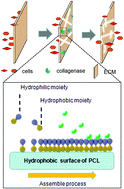An electrospun poly(ε-caprolactone) scaffold modified with matrix metalloproteinase for cellularization and vascularization†
Abstract
Rapid in vivo cellularization of implanted grafts is crucial to tissue regeneration in tissue engineering. The compositions and structures of the extracellular matrix (ECM) are important in regulating cell attachment, proliferation and migration. ECM remodeling, especially degradation, is closely related to cell migration under physiological and pathological conditions. Matrix metalloproteinases-1 (MMP-1, Collagenase I) could degrade collagen I in the ECM. So we put forward the hypothesis that ECM degradation regulated by MMP-1 might facilitate rapid cellularization in tissue engineering. In the cell invasion test, collagenase of certain concentration (0.01 mg mL−1) could significantly promote the migration of smooth muscle cells (SMCs). Then electrospun poly(ε-caprolactone) (PCL) grafts were modified with collagenase through immobilization by hydrophobin (HFBI). Surface characterization of the material confirmed the successful immobilization of collagenase. The ingrowth of SMCs into the collagenase-modified membrane was more than that into the untreated membrane. Results of subcutaneous implantation in rats indicated that the modified graft was beneficial for vascularization by promoting capillary formation. The results showed that the collagenase modified grafts could enhance SMC migration and this strategy may be a promising and attractive method for cellularization and vascularization in tissue engineering.



 Please wait while we load your content...
Please wait while we load your content...